When we looked at the route of our recent drive across Europe we realised that a visit to Krakow created the possibility of a stop at Auschwitz. This was something that we were all very keen to do and, despite a difficult week leading up to that point and a very long drive ahead of us, we committed to making the stop and taking the time. I’m very glad we did.
We had a long drive ahead of us that day. We were due to Budapest that night and, with an ailing car, we had to go the long way via Brno. That meant we didn’t have time to do the second half of the visit to Birkenau. This was a sensible choice. We eventually made it to a dark yet glorious Budapest just after 10pm that night. I don’t think you get the full impact without also seeing Birkenau.
It has taken me quite a while to process what I saw, what I heard and what I felt. I obviously knew quite a bit about what happened but nothing you know in advance prepares you for what you feel when you are there. It’s not the easiest thing to blog about. Many thousands of people far wiser than I have written on the subject and I don’t intend to attempt any kind of commentary like that. I write this for one simple purpose. Forget what you think you know and what you think your reaction to the events are. If you ever get the chance to go to Auschwitz (or any other of the camps) then you really must go. I’m not claiming it to be anything other than deeply sobering and extremely unsettling. But it is something that everyone should experience. Perspective is hard to come by. At Auschwitz, it hits you like one of the trains that transported the poor souls there.
We arrived around lunchtime on a very wet summer day. We were worried about taking a decorated charity car into the car park but an enthusiastic attendant in a hi-vis vest waved us in with whirling arms. Bright rain ponchos lit up the car park with colour. People huddled under brollies as they shuffled quietly towards the door.
Inside, people dried off as they buzzed about the busy foyer, reading signs and working out what to do. Entrance is free, but you need to get a guide – so we found the queue to pay for the guide. As is my way, I ran to the loo. A man outside the loo didn’t have a zloty to get in, he was in a debate with the toilet attendant. I gave him a zloty; perhaps fueled by the need for a decent human spirit that fills the place.
The process for paying for the guide seemed a little painful but, as ever, Tom Hagen sorted it. But that feeling you get when things appears to be needlessly complex was emerging. Then we had to, sort of, queue again to get our headsets. This was a general melee of people pushing towards the headset desk and a small funnel through a barrier, behind which guides stuck up signs indicated their language. It was unnecessary and poorly organised and, in that standard British way I was inclined to start tutting and forcing out loud exhalations. As I got squeezed towards the barrier, the pressure from the crowd around me increased. And then I felt very unsettled. There was I about to start moaning about a poor entrance process in a place where it was all too easy to imagine people getting forced off crowded trains at gunpoint, cold, terrified, hungry. I was disturbed and angry at myself. Perspective. A little bit of a guddle and a squeeze getting in didn’t matter.
We emerged back into the rain and waiting for everyone to get their headsets working and tuned to the right channel for our guide. I was being considerably more patient at this point and was even happier that I had bought a rain jacket while in a drookit Berlin.
All set and listening, we headed across a puddled path towards the famous gates. I had decided not to take my DSLR in with me. I wasn’t sure if I’d take any photos at all.
Our guide told us the history of the camp, a former Polish Army site and how the brick buildings we could see were from that original use. I was already feeling sombre. Could see the same in the eyes of my friends.
We entered one of the first buildings. The building itself was unremarkable. It could have been any old school building. Steps led up to a corridor from which rooms branched out on either side. The large empty spaces had been converted into exhibition areas. Photos on Walls, display cabinets. Like any other museum. But unlike any other museum.
We were told and shown the history of the site from the early use by the Germans. Exhibits showed the photographic evidence that remained and artefacts that survived the destruction ahead of liberation. Some of these I had seen before on TV and in books but up close they have more impact that I was ready for.
The large display of hair is hard to take it. There is just so much of it and, you are told by the guide, that this is just a small amount. It’s hard to get to grips with quite how many people died in that place. When you see the visual evidence of such a small percentage of the lives lost it is staggering. You get exactly the same feeling from the display of shoes and the suitcases taken from people after the came off the trains. The suitcases are very poignant. Names and addresses are written on them indicating how there was originally only a worry about losing possessions rather than life.
In the early days of the camp, the Germans took photos of everyone who arrived so the could be identified if they escaped. This got too expensive and they changed to the tattooing of numbers. Down one long corridor, hundreds of these photos hung on both sides. Under each photo you could read their name, occupation, the day the entered the camp and the date of their death. Some of them survived as much as 6 months, many only a few days. After a short while I began to notice that the more terrified the person looked, the shorter time they survived. It was sadly easy to see real terror in some eyes and then see that they died only a couple of days after the picture was taken. Many faces had a more stoic determination, they often lasted a few months. The guide told us a story of how someone came to the site and asked for a copy of one of the photos from the archive. It was the only surviving photo of his mother. It gets more haunting when you realise that it all remains living history, it’s not just some of medieval tale of barbarity. Other people in the pictures on the walls, we were told, are still alive today.
One of the things that I hadn’t fully realised before my visit is that, aside from the basic evil of the Nazis and everything they were doing, they were also massively cynical. Probably the most obvious example of this is the ‘swimming pool‘ pictured above. I was stunned to hear that the Germans had Auschwitz insured and, one of the conditions that was imposed by the insurers was fire protection/prevention. This required a nearby source of water to put out fires. This was provided by a large pool of water which the Germans made look like swimming pool by adding pretend ladders suggesting they offered prisoners the chance to swim. There was much, much more to the cynicism, from the lies they told to people to get them peacefully on the trains to leaving toys with the young children to keep them quiet as they walked to their death.
One unexpected and unsavoury aspect of the visit was the behaviour of some of the other visitors. One room in the exhibition areas focuses on the children in the camp. A large picture on the wall shows 4 emaciated, naked children not far from death. One of the people in the group took a picture of this picture. I just can’t conceive of why anyone would do this. There may be some vague justification based on being able to show people when you return home but, honestly, I don’t get it. You need to still be thinking like a tourist to do that. By that stage, I didn’t feel like a tourist, I wasn’t there idly exploring my curiosity, I was getting kicked in the gut. How you can stop, pause and take a photo of something so harrowing? I didn’t get it.
One of other buildings we were shown was the jail/punishment building. In the basement there were many cells were people were held in solitary confinement ahead of execution in the courtyard outside. Some of the cells were ‘standing’ cells, only big enough to stand in to deprive the prisoner of sleep. One of these had been knocked out/cut away so you could see the size of the area. I didn’t see it but the same guy stood in the standing cell and got his photo taken. Seen by my friends, they muttered displeasure as we left the building. Astonishing. Really astonishing. But probably not wholly surprising.
I really struggled with the pile of children’s shoes on display. I stood looking at them for several minutes. If you think too hard you can end up in tears pretty quickly. So many small feet. I’m trying very hard not to sound trite. And it is perhaps beyond me to describe this. And maybe that, more than anything, is why I say that everyone must go if they get the chance.
On leaving the area with the main blocks, we headed out to the perimeter and towards the gas chamber. The very words are unsettling so we shuffled through the heavier rain even quieter than before. Signs urge respect at the door. An entrance room leads to a door to the chamber itself. Myself and WDG approached the door together and, with an obvious pause, we helped each other through. I’m not over-dramatising. It is NOT a nice feeling going in there. There were fingernail scratches on the wall. As soon as I saw these I started feeling very claustrophobic. What else can I say? Horrific.
We left the chamber and passed by the furnaces. I shuffled by, not really able to make any sense of what I was seeing. As I write this several weeks later, I’m still not sure I can. Bad things happen to people. Everyone has their sadness and their misfortune. You can accept that as part of living. But you can’t make any sense of being systematically wiped out but other humans. We had come from Berlin a couple of nights before. I had eaten schnitzel and drank beer from a large glass. I complained about the rain. The German people were all lovely. I still don’t understand how any of that could happen.


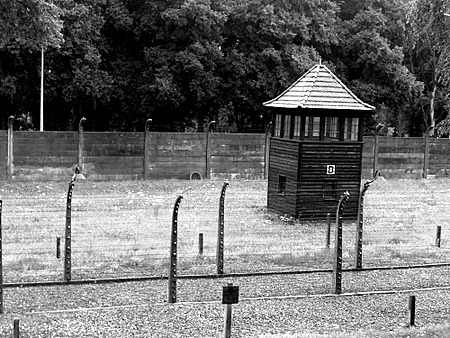
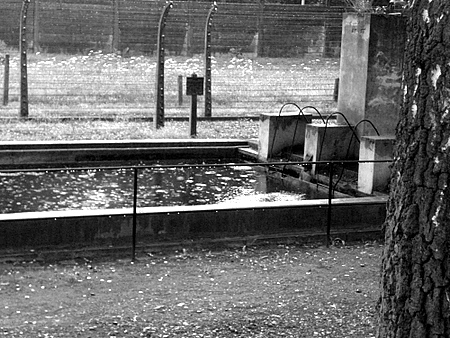
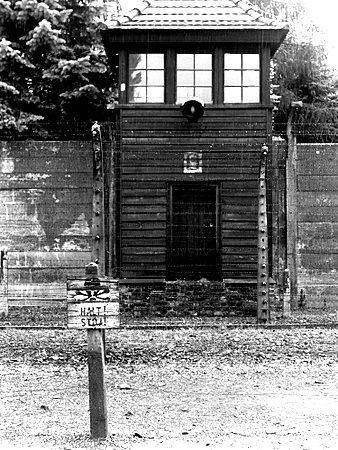
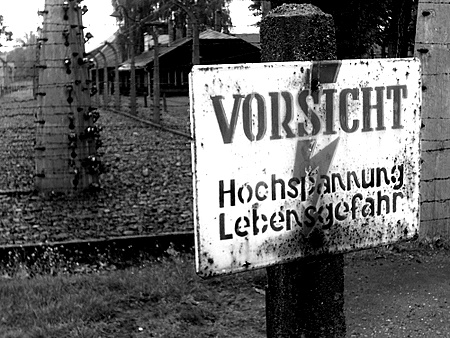
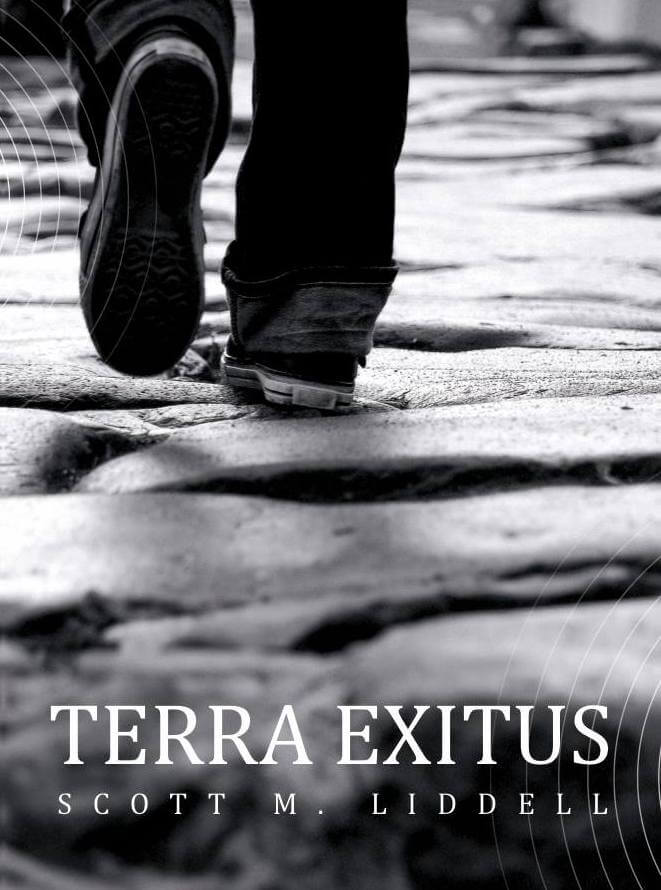


Excellent post. Very poignant indeed. I feel the same way, when I watch ‘The Final Solution’ episode of the BBC series ‘The World at War’. Utterly horrific. There’s a clip of an SS officer inspecting a Jewish man, as though looking at an animal. The SS officer uses his horsewhip, pressing it under the Jewish man’s chin, and it is just so cold, so callous and so brutal, even though it isn’t really that violent a moment.
I think it is imperative that every single person understands what has happened, in the 20th century, in Germany – in these death camps. So many people have no idea. Just look at the terrible YouTube comments on Nazi videos. I am shocked, genuinely shocked that Holocaust Deniers have gotten the foothold they have. The only way to stop this nonsense is absolute truth: to expose every person to the horrors of the Holocaust. If every person was showed ‘The Final Solution’, with the emaciated bodies being shunted around by bulldozers, with the admissions by the SS guards/executioners, with the awful stories told by the survivors.
If given the chance, every person should go, as well, to auschwitz or another death camp, to be shown what happened there. In 15 years there may be no more Holocaust survivors left ! This can never be forgotten. I think it is almost the most important piece of history of the modern era, because it shows the combined power of mass media, ignorance, bigotry and dehumanisation. We are not free of dehumanisation yet. People still regard whole swathes, millions of others, as categories, and can disregard them from the human race with frightening ease.
The history of the Holocaust shows the eventual, inevitable conclusion of bigotry when applied on a mass scale by a violent, committed demagogue. Genocide has happened many times, sadly, since then. It must not. It should not. If everyone knew the full history of the Jewish people, and particularly the Holocaust, then they would no longer, in my opinion, be willing participants in bigoted genocide.
Nonetheless, we all have to learn it, we must know what humans are capable of. It is so incredibly important. It is hard, and it should be hard ! I thank you, Scott, for not only making the visit, but for writing it down. So clearly, so movingly.
PS – one thing: the people who took the morbid photo, I understand that seems pretty messed up, but perhaps they thought, ‘that is the most horrible thing I’ve seen yet, and if I do not have a pictorial record of it, the horror may fade in my mind, and I do not want that to happen’. Certainly, I remind myself of the horror of the Holocaust every few months, because I do not want to forget it, and become callous. It is intensely hard to remind myself, but what is my pain compared to that of the people who lived it ? The poor innocent souls who were brutalised and murdered, burned to ash by the psychopathic regime of Hitler. My pain is nothing – I MUST remind myself, so that I can do my part as a human to NOT LET it EVER happen again.
PPS – I feel compelled to mention that I have German heritage – my Mum is German, and she was born just after the war. Her father, my grandfather, was a member of the Luftwaffe, who was a crew member (a navigator I think) on a bomber which was shot down over the Soviet Union. He spent from about 1942 to 1946 in a POW camp, in the USSR. (Yep, he was kept after the war was over.) My grandmother was a housewife. While she was a communist in her politics, and she seemed a somewhat troubled woman, and a somewhat troublesome woman in many ways. But as a German citizen through the Nazi years, we don’t know if she did anything to speak out against the regime, but we doubt it. She was likely the same as others in her political life. She died when my mother was very young, so my Mum was an orphan from her early teens, and had a bad relationship with her Mum, so we don’t know too much about Mum’s parents and what they did in the war.
It is a shame. I feel, in a way, like I don’t want to ‘make excuses’ for my grandparents – but I still love them, even though I never met them. I know they weren’t Nazis. But I don’t know if they knew about the treatment of the Jews or not – presumably they knew Jews were being mistreated, locked up, etc. I don’t know if they knew about the death camps, but I assume most Germans did not know, and so I assume my grandparents didn’t know either.
It is not like it is a source of great shame in my family, but every normal German, I think, feels somewhat responsible for the Holocaust, and feels great shame, and self-loathing for this episode. Thankfully the laws and the actions of the citizens since that time, have been so strict that Germany will never be a militarised, warmongering nation again, and more importantly, it will never harbour hate speech again. Nor would any German want it that way. But it is a dark, horrible part of German history, and I wish it were not, but it is. all Germans resent their history, their actions, the actions of their forefathers – and they look at the contributions of the Jewish people to science, technology, art, music, and every field, and humanity in general, and they feel, I think, a sense of great loss, that they could have been part of a country that took so much from the world, and so violently and barbarously. There is no other human response, when one learns one is German, and when one learns of what happened in Germany. So while I typically despise generalisations, I think there is one generalisation I can make: when a German learns history, he learns it not from the perspective of the ‘ally’, such as in England, US, australia, NZ, etc. He learns it from the perspective of the nation which put to death some 6 million Jews, some 10 million or more of other people, started the war that killed 50 million or more people in this century. He feels revulsion, shame, guilt and horror. His mind recoils. What other human response is there ?
I think that immigration has changed the face of Germany in recent years, and that is a good thing. I hope Germany will continue to teach history to its children as it has done, and does today: that the Holocaust is central to the Nazi story, and that the Nazi story is central to German history in the 20th century. It should NEVER be forgotten. Its impact should NEVER be reduced. EVERY PERSON must know what happened, the power of what happened.
Those childrens shoes you mentioned – they are so strong a reminder of the mass murder, since even the hardest hearted denier has trouble with the fact that millions of children, unfit for labour, were taken from ghettos to trains to gas chambers and gassed, some clutching at their mothers, some clambering on top of a human pyramid which the victims formed to try to get the children out, others hiding at the very bottom of a human pyramid formed to protect the children from the gas. This is not some story. This happened. Routinely. The shoes are a physical reminder: they once belonged to children. Everyone should see them.
Thanks again ! Sorry for the long comment. Powerful post though Scott – really well written.